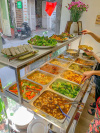
What’s the difference between eating pasta in the US and eating pasta in Italy?
Among the differences:
As others have said, portion sizes are typically smaller in Italy.
What we refer to as “sauce” is referred to throughout Italy as a “condiment.” Its role is to accentuate the flavor or texture of the noodle, not to dominate it. There is less sauce throughout Italy than one typically finds in the US.
The Italian-American palette features garlic prominently. Wide areas of Italy do not have such enthusiasm. Generally speaking, the tolerance for garlic increases as one heads north, although there are a few enclaves of garlic lovers in the south. Just as a data point, a common preparation in Rome is to throw a whole garlic clove into enough tomato sauce for 4 servings, but remove the clove prior to serving. The idea is for a faint perfume of garlic, not mouth full of garlic.
There are strong cultural associations with different types of pasta. In Rome, gnocchi is served on Thursday. Because… because it just makes sense. (Not that it’s unavailable during the rest of the week… it’s just that there’s this well-known concept that Thursday is gnocchi day.) In the same vein, there are some condiments that just don’t go with some noodles. This is known to the same degree of certainty as any law of physics. Rigatoni carbonara? It’s completely impossible.
Just a little digression on that point: I lived in Rome for 5 months. Soon after my arrival, I found a pizzeria I liked, so I went there for lunch very often. A typical Roman pizzeria has large pizzas pre-made. Slices are cut to order, and then optionally heated. My Italian wasn’t that good, but eventually the staff started to recognize me and we’d have very basic conversations.
After a while, I got the drill: I’d point to a slice of pizza, they’d say “Scaldo?” (“heat it up?”), and I’d enthusiastically say “Si!” One day, I chose two slices of pizza, one of which had “puntarelle” (a type of bitter green vegetable), burrata (a type of milky white cheese), and anchovies. The person asked, “scaldo?” I said “Si!” The person then put only one of the slices in the oven. I pointed to the puntarelle, and quizzically repeated: “Scaldo?”
The person just chuckled a little, like how a parent would laugh at a child at play. She chuckled, shook her head, and just said: “Ha… no.” The translation might have been, “Stupid American. I will save you from yourself.”
I tried again the next day with a different person, this time a man. Again, two pieces of pizza. When I suggested that I’d like the puntarelle pizza heated up, he looked at me sternly as if I just insulted his mother and said “No!”
I later asked my neighbors — who, thankfully, spoke English. When I suggested I wanted to heat up pizza puntarelle, they looked at each other strangely, as if they didn’t understand what I said. Then they looked at me, in disbelief, “why would you want to do that? That’s not done.”
So… that’s just not done. I guess? Okay, continuing with the pasta distinctions…
Although tomatoes are an important ingredient, they’re not as ubiquitous in Italian sauces/condiments as they are in the US. Often, olive oil is the “foundation” of a sauce throughout Italy.
I keep saying things like “in Rome” or “throughout Italy.” The reason is that Italian concepts of cuisine in general, and pasta in particular, vary — sometimes intensely — by region. It’s not that you won’t find “foreign” sauces on the menu outside of their region of origin, but they won’t be on equal footing with the local preparations.
In that sense, there’s almost no such thing as “Italian food.” The culinary sensibilities in Venice — a region characterized by wealth and, thanks to Marco Polo, a historical international port — diverge significantly from the culinary sensibilities in Puglia — a region often characterized by poverty
The pasta is almost always “better” in Italy than in the US — at least in my experience. It’s not so much that Italians have more history and expertise in preparing pasta, nor do they have access to some kind of secret knowledge. It’s just that the ingredients are better. Their eggs are better. Their tomatoes are better. Their olive oil is better. When you start like that, your finished product is going to be better.
(Why are the ingredients better? Again, not because of arcane, secret knowledge I don’t think. Italy enjoys certain logistical advantages over the US: it doesn’t have to feed nearly as many people, and it doesn’t have to ship ingredients over such long routes. So its agricultural practices don’t have to be scaled up to the degree the US’s do, with all the compromises such scaling entails.)
It’s hard to describe what “better” means in this context. It’s as if all the flavors have more of an identity. Eggs really taste like eggs, milk really tastes like milk, etc.
Xem thêm bài có từ khoá:
























![[VIDEO] SERIES PHÚ QUỐC (P4): PIZZA GỎI CÁ TRÍCH ĐỘC LẠ](https://vi.alongwalker.co/img/post/100x100/53031.jpg)










![[VIDEO] Biến cơm nguội thành pizza siêu dính](https://vi.alongwalker.co/img/post/100x100/47793.jpg)


![[VIDEO] Pizza đơn giản tại nhà](https://vi.alongwalker.co/img/post/100x100/45649.jpg)
![[VIDEO] Một chiếc bánh pizza và câu chuyện của anh em tui](https://vi.alongwalker.co/img/post/100x100/45611.jpg)


![[VIDEO] CÁCH LÀM PIZZA VIỆT NAM](https://vi.alongwalker.co/img/post/100x100/44819.jpg)

![[VIDEO] Tự Làm Pizza Tại Nhà | Hướng Dẫn Cách Làm Pizza](https://vi.alongwalker.co/img/post/100x100/44761.jpg)

![[VIDEO] Tự Làm Pizza Tại Nhà](https://vi.alongwalker.co/img/post/100x100/44236.jpg)









![[VIDEO] [Nấu và Ăn] Pizza trứng](https://vi.alongwalker.co/img/post/100x100/41216.jpg)












































![[THẤT TỊCH ĂN GÌ: SpaghettiBox ]](https://vi.alongwalker.co/img/post/100x100/52555.jpg)


































![[Q.5] GHI ĐIỂM VỚI CRUSH SIÊU LÃNG MẠNG](https://vi.alongwalker.co/img/post/100x100/45363.jpg)

![[VIDEO] FOOD | SỰ KẾT HỢP ẨM THỰC NHẬT - Ý TRONG 1 MÓN ĂN](https://vi.alongwalker.co/img/post/100x100/44983.jpg)






![[VIDEO] CÁCH LÀM BỮA ĂN NHẸ DINH DƯỠNG CHUẨN CHÂU ÂU](https://vi.alongwalker.co/img/post/100x100/42383.jpg)
![[VIDEO] Buffet nướng Hàn chỉ 158 cành](https://vi.alongwalker.co/img/post/100x100/41417.jpg)

